
How to make an urgent and affordable return to the Moonby Ajay Kothari
|
| It is not a space race as a military competition this time around, but will devolve into an economic one—a “space race” nonetheless. |
China’s activities in space are not just for economic or for military superiority, though they may be a side benefit. They are doing it also for civilizational pride, which morphs into national pride. It is very strong. The motivating factors in the near future are not going to be just financial. The Chinese feel that they were an exceptional civilization for a long time. They want that again and understandably so. That is what will motivate Russia, India and Iran also: the past motivating the future. We need to compete too.
First, a caveat: the arguments made herein hinge on the findings so far of abundant water ice, which today appear to be of high certainy based on the thoroughness of the work performed so far by NASA and scientists as outlined below. If, on the other hand, subsequent observations, such as by Chandrayaan 2’s orbiter, find that there is not such an abundance of water, then all the arguments below for the need and haste will be invalid and we should continue on the present path. This is the caveat in whose backdrop the rationale below is made. The Chandrayaan 2 orbiter has L-band and S-band synthetic aperture radar (SAR) onboard that is able to penetrate as deep as five meters below the lunar surface. This is enough to thoroughly map both poles for water ice. We hope to know the results soon.
With the Chang’e-5 sample return mission launching in several months, within a year or so of Chang’e-4, it is hard to believe that Chang’e-6, 7, and 8 will launch as late as 2023 to 2027, and the crewed mission in 2030s as they announced. It likely will be a lot sooner. They are not divulging what is up their sleeve, nor do they have to.
Recently they also unveiled their version of Orion. Would they unveil it now if they planned to use it a decade or more from now? No, it appears that that they may have humans there in as little as five to seven years. And it will not be for any other reason than to start to set up water extraction plants. It is not a space race as a military competition this time around, but will devolve into an economic one—a “space race” nonetheless. They may well be the first to extract water. China is also competing with India, though India lost some ground in the Vikram lander mishap. All in all, it may become a multi-country competition.
This is why going to the lunar surface is very important for the United States. This time it is of course not just to visit, or even just to stay. That is not enough. It is to do.
This implies we not only will need to be there in large numbers but also quickly, in order to compete or to reach a favorable distribution. Those at the table write the rules. All of the above means we need a solution that can take thousands of tons, not hundreds, of infrastructure and consumption material to the lunar surface.
This problem cannot be solved by just the Space Launch Sysem as it is five to eight times more costly than the approach outlined here, and is expected to have much less frequent launch capability. We will need five to ten launches a year of the type described herein to take the requisite infrastructure and material to the lunar surface (and not just to the lunar Gateway.) This also means that the lunar Gateway, while an attractive vision, is going to be counter-productive to what we need to do soon—which is all on the surface—and very costly, which will put a damper on any further Moon/Mars developments. It could negatively affect the entire program rather than help it. Going to Mars using this method is also faster, and it can be done in four years. And later, using in-situ water-ice from the lunar surface with gravity assist would be an attractive choice as well. The SLS program can be readdressed to design and produce the upper stages for different destinations using different (possibly methane and hydrogen) fuels and different payload sizes, and also the exploration concepts and hardware.
And excitement for those of us on Earth? Imagine a thousand people living there, even for just a few months at a time. Imagine people being trained on Earth, hundreds at a time, as replacements for the ones coming back, again and again. Imagine working on water ice extraction plants, purifying it—possibly using solar panels—on the south pole for drinking, for breathable oxygen, and for creating liquid hydrogen and oxygen (hydrolox) at a propellant plant that could go on for decades. Imagine selling them to customers needing to go to other planets and satellites using the rockets that have already landed there. Imagine taking advantage of Moon’s one-sixth gravity to escape from there. Imagine taking off from the surface, going to low lunar orbit (LLO), then the trans-Earth injection, and finally using Earth’s gravity and the Oberth effect at perigee to accelerate in order to escape: much less propellant and much smaller size to do the same exploration to many points in the solar system.
| This implies we not only will need to be there in large numbers but also quickly, in order to compete or to reach a favorable distribution. Those at the table write the rules. |
The almost escape velocity delta-V required from the Earth’s surface, of about 11 kilometers per second, becomes about 3 kilometers per second if taking off from the Moon’s surface. This entails a propellant fraction for hydrolox of about 0.5–0.55, a very small number with resultant ability to increase the payload substantially. Using the method delineated here, many upper stages and Orions can be lying on the lunar surface to be used for such endeavors as well as for habitats over many decades.
Imagine watching a daily livestream of these adventurer astronauts exploring the unknown facets of lunar topography, going into lava tubes tens can be tens of kilometers wide, finding new resources and unknown vistas. Imagine some entrepreneur making money doing “pay-per-view.” Surely some of this will not remain exciting after many years, but by then we will have found something else equally exciting then, as has happened with almost everything else in the world.
This can be started in a few years and can be happening in ten. Water extraction is a national emergency issue. NASA needs to be funded by Congress at least at the level they have asked for and more.
This scenario can actually be more exciting—amazing “optics,” as they say in politics—with a larger, continuous public following for a longer time than a Mars mission. The whole country of India was transfixed for the Chandrayaan-2 landing even though it regrettably did not pan out at the very end. A journey to Mars is long. Who on Earth would be excited to watch these astronauts in the capsule for six months? Even they themselves will suffer boredom from the tedious and humdrum nature of it all for six months, similar to an ISS expedition, which is still televised but which most people do not watch. But going around on the Moon’s unknowns would be highly watchable by not just US but the world. It would certainly be immensely exciting to see them land on Mars, but the same length of journey back will still weigh heavily on their minds. We should not deemphasize one for the sake of another. We need to do both. And we can.
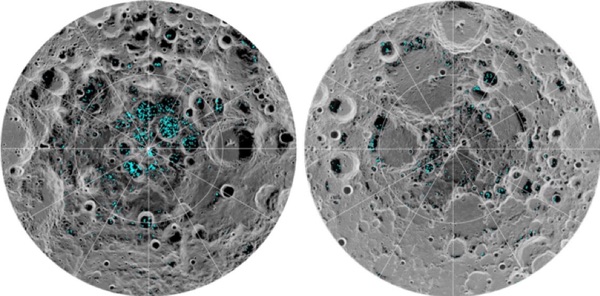 The image shows the distribution of surface ice at the Moon’s south pole (left) and north pole (right), detected by NASA’s Moon Mineralogy Mapper instrument. Blue represents the ice locations, plotted over an image of the lunar surface, where the gray scale corresponds to surface temperature (darker representing colder areas and lighter shades indicating warmer zones). The ice is concentrated at the darkest and coldest locations, in the shadows of craters. This is the first time scientists have directly observed definitive evidence of water ice on the Moon’s surface. (credit: NASA) |
An estimated 600 million ton of water ice has been confirmed to exist at the poles, perhaps more. In the darkest and coldest parts of its polar regions, a team of scientists has directly observed definitive evidence of water ice on the Moon’s surface. These ice deposits are patchily distributed and could possibly be ancient. At the southern pole, most of the ice is concentrated at shadowed lunar craters, while the northern pole’s ice is more widely, but sparsely spread.
Moon Minerology Mapper (M3) of NASA, aboard the Chandrayaan-1 spacecraft, launched in 2008 by the Indian Space Research Organization, was uniquely equipped to confirm the presence of solid ice on the Moon. It collected data that not only picked up the reflective properties we’d expect from ice, but was able to directly measure the distinctive way its molecules absorb infrared light, so it can differentiate between liquid water or vapor and solid ice
Direct evidence of surface exposed water ice in the lunar polar regions was found by a team of scientists as published in the Proceedings of the National Academy of Science in September 2018:
We found direct and definitive evidence for surface-exposed water ice in the lunar polar regions. The abundance and distribution of ice on the Moon are distinct from those on other airless bodies in the inner solar system such as Mercury and Ceres, which may be associated with the unique formation and evolution process of our Moon. These ice deposits might be utilized as an in situ resource in future exploration of the Moon.
| We need practice for going to Mars, lots of practice. God has gifted us a huge rock to practice on so very close, and easy to access. |
Some have questioned the strategic importance of Moon. While not militarily crucial or even expedient, it is nonetheless of strategic importance for our economic and exploration future. Deemphasizing “back to the Moon,” even in favor of going to Mars as a priority, would be a mistake. It would hurt us as a country in the long run.
We need practice for going to Mars, lots of practice. God has gifted us a huge rock to practice on so very close, and easy to access. As Krafft Ehricke said, “If God had wanted mankind to become a spacefaring species he would have given them a moon.” Indeed. Let us take advantage of it so we make only minimal mistakes in going to Mars, which are bound to occur.
To evaluate the ability of New Glenn for going to the lunar surface with multiple flights and the upper stage docking and/or refilling in LEO (similar to doing the same with Falcon Heavy; see “Six-pack for Mars: A railroad to the Moon and Mars”, The Space Review, September 17, 2018), it was imperative to obtain its dry weight. No weights of any kind are available from Blue Origin for either the upper or lower stage of the rocket. Only payloads to LEO (45 tonnes) and GTO (13.6 tonnes) are available. Hence based on these, an attempt was made to replicate the payload numbers using HySIDE’s component-based subsystem equations to build the Upper Stage. Th New Glenn upper stage was built in HySIDE of Astrox. So with the caveat that the numbers computed and shown below would likely be approximate, they are presented here.
The BE-3U engine was also designed in HySIDE for the expander cycle, which yielded a specific impulse (Isp) of 463.5 seconcs. Liquid hydrogen density of 68 kilograms per cubic meter and liquid oxygen of 1,153 kilograms per cubic meter was used. The upper stage was flown from staging to an altitude of 250 kilometers at 51.6 degrees inclination (the New Glenn payload user’s guide says >200 kilometers altitude) for LEO. Given below are some of the pictures and rough weight numbers, which may or may not match theirs but they may be close enough to conclude what we do below.
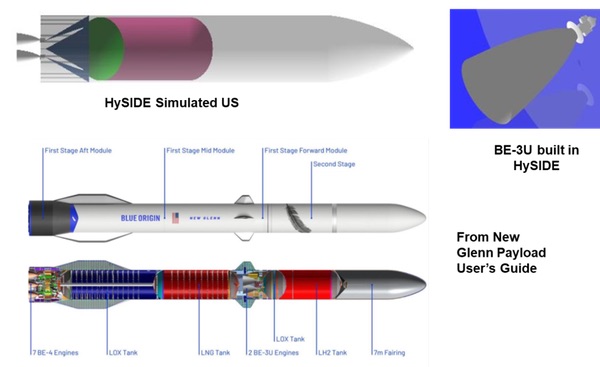 New Glenn upper stage (US) weights as an output of HySIDE |
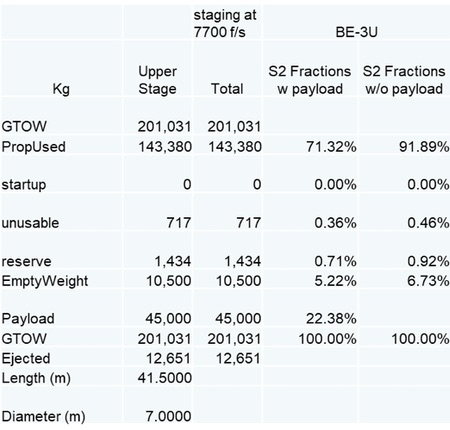 |
With New Glenn as the booster, we have multiple permutations available with three degrees of freedom: payload size, number of flights, and the number mated in orbit. This allows us to reach different possible solutions depending on need and cost. BE-3U (with liquid hydrogran and oxygen) for the upper stage is used for all the options below:
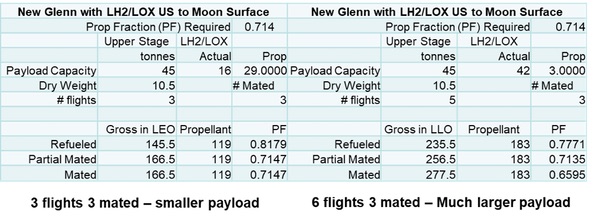 |
Extending the same “railroad” idea, six flights of New Glenn with three upper stages being refueled and 3 discarded, allows us to take almost five tonnes to the surface of Mars. Two of the three upper stages land on the surface with one continuing in low Martian orbit, which can be used for coming back to Earth. On the other hand, five flights with all refueling the in-orbit upper stafe from the first flight, allows for 16 tonnes payload.
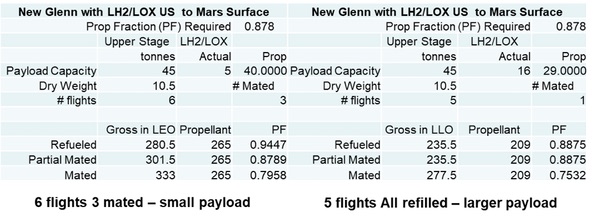 |
A “railroad” to Moon and Mars is indeed possible if we can cleverly take advantage of reusability of the first stage(s) as proposed here. Upper stage docking (using docking collars or adapters) has been done since 1966. Refueling has been done by Soyuz to ISS. We will need to perfect them, though. The second stages are also effectively reused as their tanks become homes. So we can attain the reusability of the upper stage without having to increase its dry weight if they were completely reusable. (Reusable second stage also increases the first stage weight by almost a factor of 2.1.) Thus we can have the best of both worlds with this concept.
At a cost seven times cheaper, Falcon Heavy and New Glenn are suggested here for only cargo payloads, of which many thousands of tons will be required for doing what is discussed above. The procedure suggested here will avail us many possible permutations of payload, number of flights and number of upper stages mated (even up to a payload of 51,700 kilograms to the lunar surface) with the possibility of numerous permutations at our fingertips, depending on the need at that time. This is the railroad.
| Such an approach can find a solution for any exploration option we will need to do for almost the entire solar system over next several decades. |
Exactly one century after building the first transcontinental railroad in six years, we built Saturn V as the railroad to the Moon in almost the same time. Now, exactly half a century later, it is time to build another “railroad” to the Moon, Mars and other worlds in the solar system. It can also be done in almost the same time span. Meanwhile, a human-rated Starship and SLS would be used for crewed transportation.
All these mean that while we are building lunar colonies, we can, at the same time, be sending spacecraft to Mars within the next presidential term. It does not have to be a one-or-the-other type solution (Moon or Mars). This can be done at the cost of ~$1 billion for Mars.
Such an approach can find a solution for any exploration option we will need to do for almost the entire solar system over next several decades. This should be taken up by NASA as the modus operandi going forward, but only for cargo payloads. A virtual trans-planetary railroad thus can be built for the country and for humankind.
Note: we are temporarily moderating all comments subcommitted to deal with a surge in spam.